Binchotan and water purifier
When fired at high temperatures, Binchotan and white charcoal undergo a transformation that makes them alkaline, making them ideal for water purification. In contrast, black charcoal, which is fired at lower temperatures, becomes acidic.
Unlike other types of charcoal, Binchotan maintains its structural integrity and releases mineral-rich powder when submerged in water. Its myriad pores act as a natural filter, effectively removing harmful substances like chlorine from the water.
Binchotan Under a Microscope
When wood is transformed into charcoal, it shrinks, reducing its volume to about one-tenth, resulting in a texture similar to that of stone. Examining Binchotan charcoal under a microscope reveals countless pores, formed as volatile components evaporate during the carbonization process.
These pores play a crucial role in Binchotan's filtering capabilities, trapping numerous particles. Images of well-used Binchotan pieces showcasing how these pores capture particles can be viewed here: http://www.technex.co.jp/tinycafe/discovery03_04.html http://www.technex.co.jp/tinycafe/discovery03_05.html
Dissolving minerals
Binchotan contains various minerals, including potassium (K), magnesium (Mg), and calcium (Ca). While these minerals are naturally present in trees, they are not readily soluble or accessible in water. However, during the carbonization process that transforms wood into Binchotan, these minerals undergo a transformation, becoming water-soluble and more easily absorbed by living organisms.
This attribute is particularly beneficial for individuals living in areas where local tap water is soft and lacks essential minerals, as Binchotan can help enrich the water with vital nutrients.
The Mystery of the Drilled Holes in Binchotan
Interestingly, the Binchotan pieces I received have one or two drilled holes in the middle, which initially puzzled me. It seemed counterintuitive since these holes appeared to remove part of the cellulose porous structure that could otherwise trap unwanted particles. Given that Binchotan is as hard as steel, I couldn't help but wonder why anyone would go to the extra effort of drilling a hole.
However, further research revealed that dirt and impurities are typically trapped within 200μm of the surface. By creating holes, the surface area available for trapping impurities is significantly increased, enhancing the charcoal's filtration capacity. What initially seemed like a flaw turned out to be a functional design choice.
Prepping for tasting
First, I boiled water in a pot and added a piece of Binchotan charcoal for disinfection, letting it simmer for a few minutes.
Next, I placed a small piece of Binchotan charcoal in one glass of tap water while leaving another glass with just tap water.
Tasting Binchotan soaked water
After allowing them to sit for more than 24 hours, I finally proceeded with the taste test. I alternated sips from each glass, but to my surprise, I hardly noticed any difference in flavor, which left me feeling a little disappointed.
Reflecting on a previous conversation with a kiln owner who kindly sent me a few samples — and who repeatedly asked about the area where I live — I began to understand that the effect of Binchotan on water taste may vary depending on location. Living in the mountainous area of Osaka, near the border of Nara, I was already aware that the tap water in my area is generally good. However, this experience made me realize just how exceptional the local tap water truly is.
Quality of local tap water
A quick research led me to an online post by the city newspaper. It revealed that the local tap water here comprises 70% underground water, with the remainder sourced from the river. This ratio is significantly higher than the national average here in Japan, which stands at 30% underground water.
The underground water undergoes filtration within the ground, resulting in minimal cloudiness and maintaining good water quality. The movement of water through the soil is slow, progressing at a rate of approximately 3 meters on average per day. Rainfall in mountainous areas permeates the soil, gradually absorbing minerals as it makes its way to the underground aquifers accessed by deep wells.
The groundwater currently extracted in the city is believed to have seeped into the ground from rainfall roughly 30 years ago. Due to the abundant use of underground water, which contains fewer bacteria compared to river water, the city's water treatment center utilizes less chlorine.
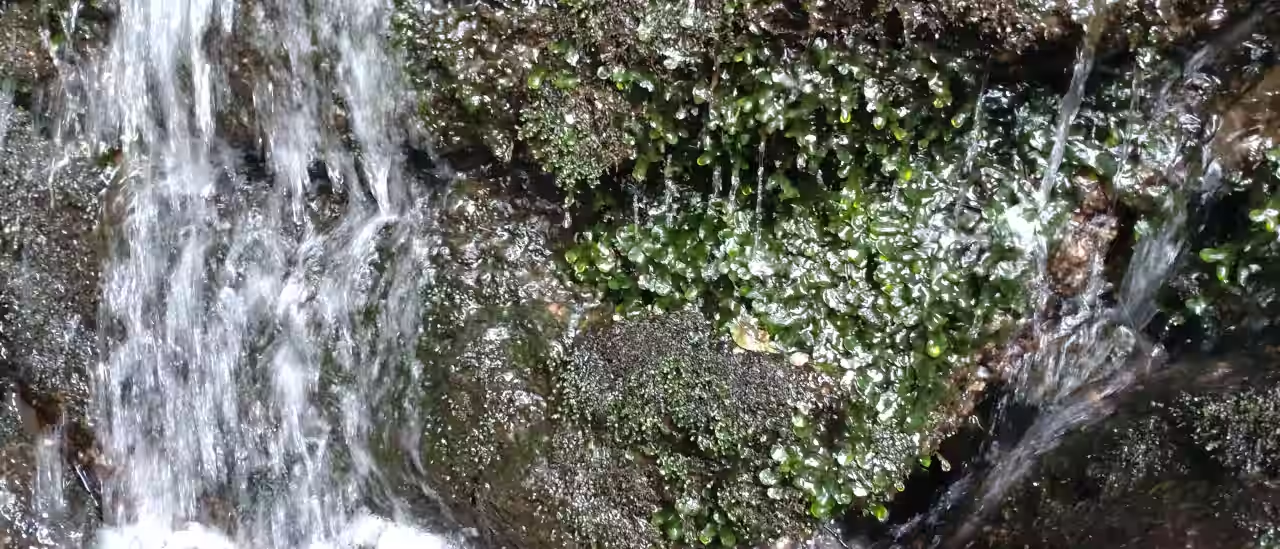 Surface water in the nearby mountains - some seeps underground
Surface water in the nearby mountains - some seeps underground
Moreover, the water purification process in my city employs the "biological contact filtration method," which is gaining recognition as a natural water purification technique that uses no chemicals. This method harnesses the power of microorganisms, particularly iron bacteria, to eliminate substances such as iron (Fe), manganese (MnO₂), and ammonia nitrogen (NH3) dissolved in groundwater.
Notably, the city's biological contact filtration pond, employing the sand filtration method, boasts the largest scale in Japan. Furthermore, the city's 100% groundwater received the prestigious Grand Gold Award at the 2019 Monde Selection.
Well, that explains why I did not detect the difference in taste. For those who aren't as fortunate with the quality of local tap water, it may be worth giving Binchotan a try.
Tasting Binchotan soaked Sake
I also experimented with Binchotan in Sake from Yamagata, which is brewed using pure groundwater from the snowy mountains. Similar to the water experiment, the Sake tasted good to me regardless of the presence of Binchotan, with no noticeable difference. I wonder if the quality of the water used in brewing plays a role here as well.
You can try using Binchotan with Sake, beer, and other beverages for enjoyment. Some reports suggest that Binchotan can enhance the taste of certain alcohols, making them smoother, mellower, and more refined.
